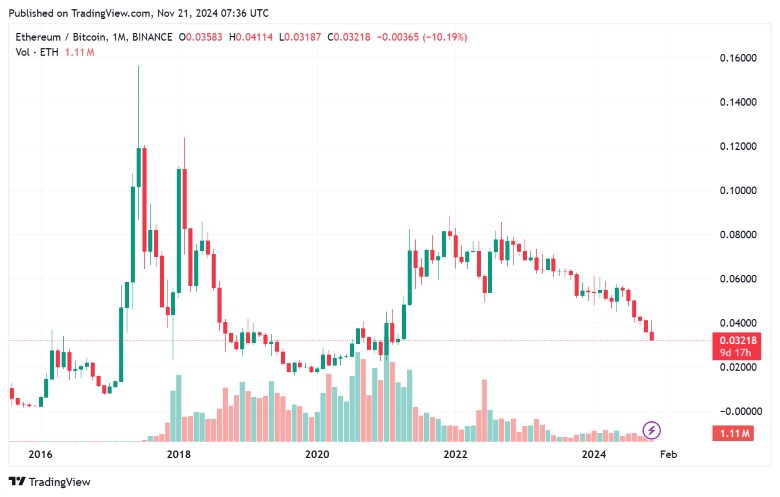Ethereum has long been considered the “oil” of the blockchain world, essential for fueling decentralized applications, smart contracts, and DeFi. Meanwhile, Bitcoin, as the “gold,” dominates the narrative as the ultimate store of value. However, as Bitcoin flirts with the $100,000 milestone and Ethereum stagnates at $3,100, ETH holders are growing restless. The central question persists: will Ethereum’s role as the utility backbone of blockchain doom its holders to sacrifice price growth for modest staking rewards?
Ethereum: A Pillar Under Pressure
Ethereum remains foundational to the blockchain ecosystem, processing over 1.2 million daily transactions and hosting $60 billion in total value locked (TVL) across DeFi protocols. It powers the majority of dApps, from NFTs to decentralized exchanges, but its market performance has failed to keep pace with its technological dominance.
In 2021, during Bitcoin’s surge to $74,000, Ethereum traded at $4,100. Now, Bitcoin is nearing $100,000, while Ethereum has slumped to $3,100—a troubling disparity that reflects deeper issues within Ethereum’s value proposition.
Why Is Ethereum Falling Behind?
1. Staking and Liquidity Trade-offs
Ethereum’s transition to Proof of Stake (PoS) locked up over 33 million ETH, approximately 28% of its circulating supply, in staking contracts. While this secures the network and provides 3.3% annual yield, it limits liquidity. For many holders, this yield doesn’t compensate for missed opportunities in a rapidly evolving market, particularly as Bitcoin remains fully liquid and speculative.
2. On-Chain Activity Concerns
While Ethereum remains active, its on-chain activity has cooled compared to its 2021 highs. Gas fees, once exceeding $50 per transaction, now average around $3, signaling reduced network congestion and demand. The NFT boom that once drove Ethereum activity has lost momentum, with trading volumes down over 70% year-over-year. Similarly, DeFi activity has slowed, reducing the revenue that once bolstered Ethereum’s ecosystem.
3. Rising Competition
The blockchain space no longer belongs to Ethereum alone. Platforms like Solana, Avalanche, and Binance Smart Chain offer faster transactions at lower costs, luring developers and users.
4. ETF Limitations
Ethereum ETFs fail to capture the full value proposition of holding ETH. Unlike direct ETH holdings, which generate staking rewards of 3.3%, ETFs exclude these yields, leaving investors with only price exposure. This structural flaw has limited ETF adoption, particularly among institutional investors, making Ethereum ETFs less appealing than Bitcoin’s straightforward alternatives.
5. Regulatory Ambiguity
Ethereum’s staking mechanism has attracted regulatory scrutiny, particularly in the U.S., where authorities debate whether staking constitutes a securities offering. This uncertainty has deterred institutions, favoring Bitcoin, which enjoys regulatory clarity as a commodity.
What Needs to Change?
Ethereum’s challenges are not insurmountable, but decisive actions are required to align its utility with market performance:
- Incorporate Staking Rewards in ETFs
Allowing ETFs to pass on staking yields to investors could make Ethereum far more attractive. Regulatory approval for such products would bridge the gap between institutional demand and Ethereum’s PoS economy. This is something might change with the new administration - Boost Network Activity
A resurgence in DeFi and NFTs, coupled with the growth of tokenized real-world assets, could reinvigorate demand for Ethereum. Layer 2 solutions like Arbitrum and Optimism, which already process over 50% of Ethereum transactions, must also play a pivotal role in reducing costs and driving scalability. - Reclaim Market Dominance from Competitors
Ethereum must accelerate upgrades like sharding, which promises to boost transaction throughput significantly. It also needs to reassert its dominance in the developer community by fostering innovation in emerging sectors like gaming, tokenized identity, and decentralized finance. - Enhance Staking Yields
While staking yields currently hover around 3.3%, Ethereum could explore mechanisms to offer higher rewards, attracting yield-hungry investors and increasing the locked supply.
The Current Dilemma: FOMO vs. Vision
As Bitcoin’s meteoric rise fuels FOMO , Ethereum holders face a stark choice: remain loyal to Ethereum’s long-term vision or chase short-term profits in other assets. For instance:
- A holder staking 10 ETH at $3,100 earns 0.33 ETH annually in staking rewards, roughly worth $1,000.
- If Ethereum’s price were to spike to $6,200, the staked holder forgoes the ability to sell at that high, potentially missing out on $31,000 in value.
This trade-off is becoming increasingly difficult to justify, especially as Ethereum’s competitors offer more lucrative short-term opportunities.

A Decision for Ethereum’s Future
Ethereum’s leadership, particularly Vitalik Buterin, faces a critical moment. While Ethereum’s technological advancements and decentralized ethos remain unmatched, these strengths alone may no longer be enough to retain its user base and investor confidence. With Bitcoin dominating headlines and other blockchains gaining traction, Ethereum risks losing both its market position and the loyalty of its holders.
The challenge is clear: Ethereum needs to realign its value proposition with the expectations of its community and investors. That means delivering tangible outcomes that go beyond its role as the “oil” of blockchain. Simply sustaining the network is not enough. Holders want to see a balance between Ethereum’s long-term vision and short-term incentives—whether through higher staking rewards, better liquidity options, or faster scaling solutions.
Failing to act decisively risks a critical outcome: Holders may abandon Ethereum’s vision to chase immediate profits elsewhere. For all its potential, Ethereum’s future depends on whether it can convert belief into tangible rewards that justify the patience of its community.











